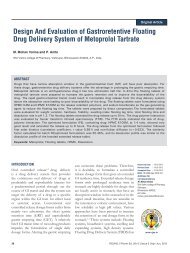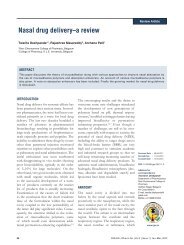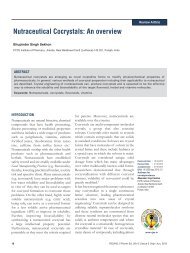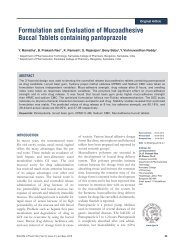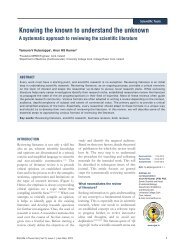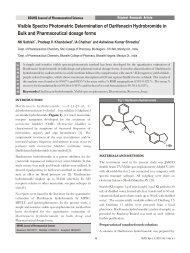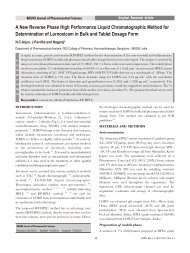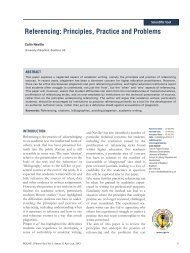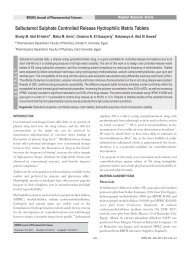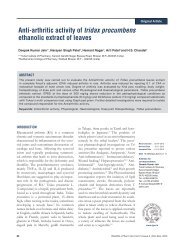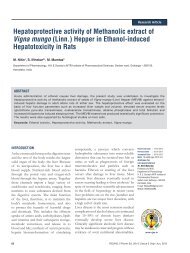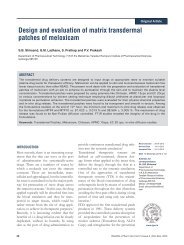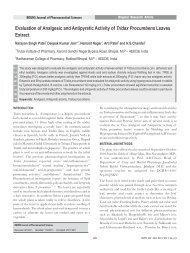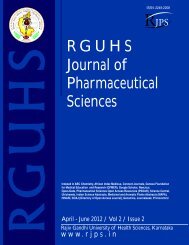Chitosan Loaded Mucoadhesive Microspheres of Gliclazide - Journal
Chitosan Loaded Mucoadhesive Microspheres of Gliclazide - Journal
Chitosan Loaded Mucoadhesive Microspheres of Gliclazide - Journal
Create successful ePaper yourself
Turn your PDF publications into a flip-book with our unique Google optimized e-Paper software.
A Senthil et al./ <strong>Chitosan</strong> <strong>Loaded</strong> <strong>Mucoadhesive</strong> <strong>Microspheres</strong> <strong>of</strong> <strong>Gliclazide</strong>: In vtro and In vivo Evaluation<br />
Fig.3: Counter Plot showing the Effect <strong>of</strong> Polymer-to-<br />
Drug Ratio (X1) and Stirring Speed (X2) on: %<br />
Mucoadhesion (a), Swelling Index (b), Drug Entrapment<br />
Efficiency (c), Particle Size (d) for Optimized Batch (A4).<br />
a b<br />
c d<br />
Fig. 4: Percentage Reduction in Blood Glucose Levels<br />
following Oral Administration <strong>of</strong> Pure Drug and Formulation<br />
in Normal Rats (n = 5)<br />
the same dose. <strong>Gliclazide</strong> pure drug was administered, a rapid<br />
reduction <strong>of</strong> 42.83% was observed within 2 hours after oral<br />
administration. Blood glucose levels were recovered rapidly to<br />
the normal level within 8 hours. In the chitosan loaded<br />
gliclazide mucoadhesive microspheres, the reduction in blood<br />
glucose levels was slow and reached maximum reductions<br />
within 4 hours after oral administration were shown in (Fig. 4).<br />
This reduction in blood glucose levels was sustained over a<br />
longer periods <strong>of</strong> time 10 hours. Kahn and Shechter have<br />
suggested that a 25% reduction in blood glucose level is<br />
34<br />
considered a significant hypoglycemic effect . 25% <strong>of</strong><br />
169<br />
hypoglycemic effect was maintained for a period <strong>of</strong> 0.5 to 2<br />
hours period after oral administration <strong>of</strong> pure gliclazide. In<br />
the case <strong>of</strong> gliclazide mucoadhesive microspheres shows<br />
significant hypoglycemic effects was maintained for a period<br />
<strong>of</strong> 1 to 9 hours. The sustained hypoglycemic effect observed<br />
over long period <strong>of</strong> time because <strong>of</strong> the mucoadhesive<br />
microspheres is due to slow release <strong>of</strong> drug and absorption <strong>of</strong><br />
gliclazide over longer periods <strong>of</strong> time. <strong>Gliclazide</strong> sustained<br />
release formulation is significantly more effective than the<br />
immediate release formulation <strong>of</strong> gliclazide in reducing<br />
fasting plasma glucose levels and side effects as per Berelowitz<br />
35<br />
et al . The optimized batch A4 was studied its potential and<br />
associated to control blood glucose level in animal. In this<br />
study sustained release mucoadhesive microspheres <strong>of</strong><br />
gliclazide exhibited significant important in diabetic<br />
parameters like glucose as compared to immediate release<br />
formulation <strong>of</strong> sustained drug gliclazide. It may be the other<br />
polysaccharides such as starch and other additive also contain<br />
the precursors <strong>of</strong> glucose in the formulation <strong>of</strong> oral dosage<br />
forms administrated available in market. The result reflects<br />
that mucoadhesive microspheres were sustain regimen<br />
maintain the vivo significant effect in animal models were<br />
shown in (Fig. 4).<br />
Stability studies revealed that, there was a reduction in<br />
entrapment efficiency after storage for one month at 4±1°C,<br />
25±2°C 25±2°C 60±5% RH and 37±2°C have shown<br />
maximum entrapment followed by the storage at 25±2°C at<br />
60±5% RH and 37±2°C at 65 ± 5% RH conditions. A4<br />
batch stored at 4±1°C has shown 91.12 % drug release, at<br />
25±2°C with 60±5% RH has shown 95.32% and at 37±2°C<br />
with 65±5% RH has shown 98.76%, and the percentage <strong>of</strong><br />
drug entrapment efficiency at 4±1°C, 25±°C with 60±5%<br />
RH and 37±2°C with 65±5% RH for one month was found<br />
to be 72%, 72% and 69%.<br />
The IR spectra <strong>of</strong> the pure drug gliclazide as well as the<br />
combination spectra <strong>of</strong> the drug and polymers. In all the<br />
combinations the wave numbers related to aliphatic<br />
secondary amine, carbonyl, sulphur-oxy groups were nearly<br />
same, which indicates no interaction between gliclazide and<br />
polymers.<br />
CONCLUSION<br />
2<br />
The results <strong>of</strong> a 3 full factorial design revealed that the<br />
polymer-to-drug ratio and stirring speed significantly affected<br />
the dependent variables percentage mucoadhesion, drug<br />
entrapment efficiency, particle size and swelling index. As the<br />
concentration <strong>of</strong> glutaraldehyde increases, the<br />
mucoadhesiveness decreases and there was no significant<br />
effect in time. Stirring speed has negetive effect on drug<br />
RJPS, Jul - Sep, 2011/ Vol 1/ Issue 2



